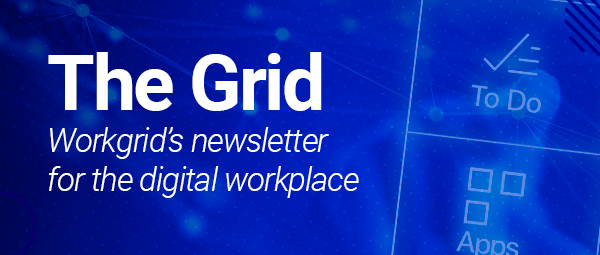It’s evolving rapidly. The dynamic adoption of Conversational Artificial Intelligence (AI) Work Assistants represents a critical juncture between technology, work, and employee experience. This is more than a trend, and far from a fad. AI is set to transform how companies operate and compete. In this next wave of digital transformation, a conversational AI work assistant is no longer just an option, it is a strategic business partner that can redefine the experience, and agility of your workforce.
The following delves into the multifaceted considerations crucial for business leaders looking to select an AI Work Assistant that aligns with their unique culture, business objectives, and technology landscape. It goes beyond the surface-level allure of AI; focused instead on how such technology can be seamlessly integrated into the fabric of a company, enhancing not just productivity but also fostering a new way of working. From ensuring compatibility with existing tech infrastructures to safeguarding data privacy, and from scaling in tandem with business growth to delivering a user-friendly experience, this piece offers a quick guide to navigating the intricate process of selecting an AI Work Assistant.
Embracing AI in Alignment with Your Company Culture
No two organizations are alike. Choosing an AI Work Assistant that resonates with your company culture is more than RFP criteria or technological fit; it's about finding a ‘digital team member’ for your organization. Conversational AI Work Assistants should understand the user, but also contribute positively to your company's unique operational dynamics by breaking down barriers. The ideal is about creating a connection across all the personas within your organizational structure, wherever they happen to work. This requires a deep understanding of how the organization is structured, operates, how differing personas work within their respective functions, and across departments. It should also consider the various friction points across the business personas to ensure value can be delivered across the organization.
This is where a greater understanding of the employee’s experience can aid in defining the right needs for the conversational AI Work Assistant. When aligned properly AI services can foster greater culture of awareness, efficiency, and collaboration. The goal is not replacement but an accelerant to the employee experience – removing the friction filled barriers of everyday work. When employees feel that they can move seamlessly through their day; more capacity for deep work can be achieved.
Consider Technology Compatibility and Integration Extensibility
With an appreciation of culture, there must be a corresponding understanding of the technological landscape. After all, an AI Work Assistant must integrate flawlessly with your existing tech stack. This requires an understanding of the technology at hand but also the ability for the assistant to broker transactions across your digital domain. The ideal scenario would be an assistant which can communicate across all areas of third-party services and solutions. However, all communication is a two-way street.
This means the right AI Work Assistant for your organization should be ready and able to integrate across the key enterprise applications – out of the box. Seamless integration minimizes not only the cost of deployment and professional services hours; but it will also aid in disruptions facilitating a smoother transition and minimizing internal development work.
It's essential for the AI Assistant to be compatible with current systems, ensuring that employees can utilize its full potential without needing extensive retraining or major system changes. This compatibility is key to achieving quick adoption and realizing the assistant's benefits sooner.
![[asset] Integrate-with-Workshop](https://images.ctfassets.net/z7p73u8c0thn/4p5cjwJwUlG5iJBwmjE5TP/3850909ef667247266e653aac08f80e5/Switchback_Integrate_3.png?w=470&h=470&q=60&fm=png&bg=transparent)
Aligning Technology and Business Objectives
The third key component of choosing the right AI Work Assistant is defining the business objectives which the technology aids. Effective understanding of your business drivers, in accordance with culture and tech stack helps ensure greater chance deployment project becomes a true employee experience program – not another project.
One way to start is by looking at specific digital friction challenges that are hampering key objectives. These may be related to workflow bottlenecks, areas of employee frustration, or delays within the overarching organizational topography that the assistant can help resolve. Whether it's streamlining communications, processes, automating routine tasks, or providing insightful proactive notifications, a focused approach in identifying these objectives will guide you in selecting an AI Assistant that is tailored to your business needs.
Choosing the Right Solutions and Use Cases
Getting the most out of a solution requires an understanding of how the AI Work Assistant will be deployed. This can be addressed by looking into the broad and deep use cases. Broad use cases address the overarching organizational base. These could be using cases related to unified communications, nudges, or larger scale employee experience ‘to knows' and ‘to dos’ which impact most employees.
Deep use cases are line of business focused. These are use cases which help to transform the way different business areas function on a day-to-day basis. For example, simplifying order and expense approvals to a single click, reducing the search time for HR policies and benefits, or streamlining the IT ticket submission process.
The approach is to have a proper mix of enterprise, business, and persona. This way stakeholders from across the employee base can derive value from the solution. In addition, value can readily be seen and felt further justifying the AI work assistant.
Scalability and Extensibility
The ideal AI Work Assistant should not only meet your current needs but also be capable of scaling and evolving alongside your company. As you begin to map out the various use cases which will build the foundation of creating a new employee experience, it's wise to ensure that your use cases can be implemented with little to no configuration.
A handful of vendors (including Workgrid Software) provide low/no-code platforms as a part of their general offering. In the case of Workgrid, we provide digital workplace leaders with the ability to stand up over 50 use cases out of the box via our app templates. In addition, connect to nearly 200+ enterprise applications from day one. This allows the AI Work Assistant to readily meet the integration needs based on the enterprise tech stack.
Last, the platform must be able to adapt to eventual shifting business requirements and/or technology replacements. Look for solutions that offer flexibility in terms of deployment, customization, and scalability to future-proof your investment.
![[asset] remote-work-stock-photo](https://images.ctfassets.net/z7p73u8c0thn/7zQKj88iQaEKAbnYDZXMLx/0cf7b488e7849855017f940edb275af1/thought-catalog-UK78i6vK3sc-unsplash.jpg?w=1200&h=800&fl=progressive&q=60&fm=jpg&bg=transparent)
Safeguarding Security and Data Privacy
In today's data-driven world, security is paramount. There are AI Work Assistants which have little to no control over what utterances may be passed over to feed a third-party LLM. Thus, an AI Work Assistant must adhere to your stringent security and privacy standards. It’s important that whatever conversational AI Work Assistant is chosen, your choice complies with relevant regulations and industry standards. Moreover, both you and the vendor understand the potential sensitive or proprietary information that may be passed back and forth from system to system – better still, you are able to bring your own LLM to further protect your data.
Identifying User Experiences
User experience is paramount for any technology adoption. There are assistants which act as another application; this is just another place to go. The AI Work Assistant should be accessible wherever the employee happens to be, intuitive to use, easy to navigate, and accessible across persona groups, regardless of their technical expertise. A user-friendly interface enhances adoption rates and encourages more effective use of the AI tool across your team.
Realizing Proper Return on Investment
Analyzing the cost versus the potential return is a critical step in choosing an AI work assistant. Consider the long-term value the AI will bring, such as time savings, increased productivity, strategic alignment, reduction of incident ticketing, potential for revenue growth etc. against the initial investment. A proper ROI calculation should be a balance of green dollars and brown dollars. Each use case selected should be aligned to a proper ROI lever in which to further justify effort. The building of the AI ai work assistant business case is a critical component, but also one which to aid ensuring the continued adoption of the solution with fiscal goals.
Strategically Implementing an AI Work Assistant
A strategic approach to implementation is key. Develop a comprehensive rollout plan, provide thorough training, and cultivate a culture that encourages employees to explore and utilize the AI Work Assistant to its fullest. This approach will facilitate smoother integration and greater acceptance among your team.
Choose Wisely: Vendor Evaluation and Selection
Selecting the right AI Work Assistant is a strategic decision with far-reaching implications. It’s not simply selecting a vendor – but a relationship. You are evaluating your own culture, technology landscape, objectives to the ability for a vendor to execute in accordance. This means they have the reliability, customer support, and commitment to innovation. Choose a vendor with a strong track record, one that offers continuous support and aligns with the latest technological trends, ensuring that your AI work assistant remains relevant and effective. This decision is not just about adopting novel technology; it's about embracing a conversational AI Work Assistant that will transform how your company operates and competes every day.
![[asset] AI Work Assistant Features Overview](https://images.ctfassets.net/z7p73u8c0thn/7c8hzpf0DaPru7mSIeUCNC/960faee7b48904d56b1977f66578d9dc/AI_Work_Assistant_Features_Hero_Image_1.png?w=1200&h=1200&q=60&fm=png&bg=transparent)




